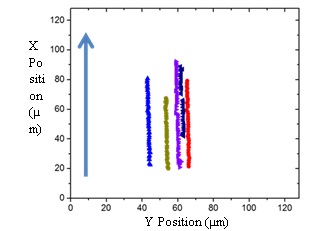Nanoparticle image velocimetry in an elastohydrodynamic contact
S. Jeffreysa*, L. Di Mareb, X. Liu,a N. Morganac and J. S. S. Wonga
*s.jeffreys16@imperial.ac.uk
aDepartment of Mechanical Engineering, Imperial College London, London SW7 2AZ, UK
bDepartment of Engineering Science, University of Oxford, OX1 3PJ, UK.
cShell Global Solutions (UK) Ltd, Brabazon House, Threapwood Road, Manchester M22 0RR, UK
INTRODUCTION: The rheology of lubricants operating in the elastohydrodynamic (EHD) regime under high-pressure high-shear conditions may reveal strong non-Newtonian characteristics. Here the flow behaviour may differ from common assumptions applied in important rheological models used to predict shear stress.1 An example of this is that the lubricant properties do not vary through the thickness of the film, such that the lubricant flow is governed by Couette shear. It is therefore vital to measure the flow profile and better understand the validity of this assumption.
Local operating conditions pose a special challenge to experimental studies of lubricant flow, particularly the thin film nature for applying conventional velocimetry techniques. However in situ flow measurements are necessary in order to understand the fluid behaviour, which is directly linked to the frictional and thermal response within a tribological contact. Previous experimental research to measure through-thickness velocity profiles has been investigated using fluorescence imaging.2,3 The objective of this work is to develop a complementary method to strengthen existing findings. This could lead to improvements in modelling friction in the EHD regime, ensuring constitutive equations are used correctly.
METHODS: In this work, a novel technique based on nanoparticle image velocimetry has been developed. Positions of nanoparticles are tracked in a 100 x 100 µm region at the contact centre between a rotating 3/4” glass sphere and stationary glass slide. The technique captured nanoparticle positions for a consecutive of 20 frames, allowing for an accurate calculation of nanoparticle velocities. The sliding speed of the ball is 360 µm/s. Local Hertzian contact pressures between 100-500 MPa were applied. Polybutene was used as a model lubricant. Previously its flow behaviour was shown to be pressure-dependent.4 Below a critical pressure, the lubricants through-thickness velocity profile was found to be linear suggesting Couette shear.4 However above the critical pressure, the flow is likely to be highly non-Newtonian resembling a partial plug flow, as the lubricant is said to experience a second-order phase/glass transition.4 In this work, the lubricant is likely to experience different flow behaviours.4 From tracking data, nanoparticle velocity distributions can be plotted and compared with through-thickness velocity profiles obtained using fluorescence imaging.

 Figure 1 - Nanoparticles tracked at contact centre. The arrow represents the streamwise direction (X). Each colour represents a different nanoparticle.
Figure 1 - Nanoparticles tracked at contact centre. The arrow represents the streamwise direction (X). Each colour represents a different nanoparticle.
RESULTS: Figure 1 shows an example of 5 nanoparticles which were tracked at the contact centre. Each point represents an individual frame capturing the nanoparticle position as it flows through the contact.
DISCUSSSION
The possibility of linking nanoparticle velocity distributions to through-thickness velocity profiles allows us to investigate the applicability of common flow assumptions used in EHD lubrication studies. Results will also give a good indication of the suitability of nanoparticles for flow velocimetry.
Results in figure 1 clearly show nanoparticles entering the contact. This can therefore be extended to important topics such as the use of nanoparticles as nanoadditives. As nanoparticles travel through the contact at specific velocities, their applicability for reducing friction in full film EHD lubrication studies can be analysed.
REFERENCES: 1. Spikes. Tribol. Lett. (2014) 2.Ponjavic. Tribol. Lett. (2013) 3. Galmiche. J. Phys.: Condens. Matter. (2016) 4. Ponjavic. J. Polym. Sci., Part B: Polym. Phys. (2014).